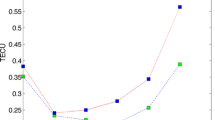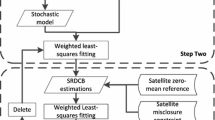Abstract
Differential code bias (DCB) is one of the main error sources of the positioning, navigation and timing services and slant total electron content extraction. The DCB can usually be estimated together with ionospheric model coefficients from the data of International GNSS Service stations. However, the precision of the BeiDou Navigation Satellite System (BDS) satellite DCBs determined with GNSS data is still lower compared with that of GPS. Apart from the sparsely distributed tracking stations of BDS, the quality of BDS observables also matters. Moreover, the determined DCB will have different characteristics for geostationary orbit (GEO), inclined geosynchronous orbit (IGSO) and medium earth orbit (MEO) satellites because of different observation times, geometric structures and orbit repeat periods of the different orbit types. In this study, we mainly analyze the factors affecting the accuracy of BDS satellite DCBs. First, a piece-wise local ionospheric model based on a two-step method is proposed to obtain the BDS DCBs. Second, the impact of BDS satellite-induced code bias variations on the ionospheric observable and DCB determination is analyzed in detail. Finally, we focus on the analysis of the cause of different day-to-day scattering results for GEO, IGSO and MEO satellite DCBs. The performance of the proposed algorithm and the satellite-induced factors affecting the accuracy of BDS DCBs are assessed by about 3 months of GNSS data in 2015 from 42 MGEX stations. Results show that the proposed algorithm is able to estimate BDS satellite DCBs precisely. The DCB day-to-day stability of BDS satellites is improved by 40.6% compared with DCB products of Institute of Geodesy and Geophysics (IGG), China. After the satellite-induced bias is eliminated by a correction model, the precision of BDS DCBs improves. In particular, the value of B1–B3 DCB day-to-day scattering for MEO satellites decreased by 28.4%. In addition, we determined that the lower DCB day-to-day stability of MEO satellites compared with that of IGSO satellites may be mainly attributed to the different satellite orbit repeat periods.













Similar content being viewed by others
References
Brunini C, Azpilicueta FJ (2009) Accuracy assessment of the GPS-based slant total electron content. J Geodesy 83(8):773–785
Ciraolo L, Azpilicueta F, Brunini C, Meza A, Radicella SM (2007) Calibration errors on experimental slant total electron content (TEC) determined with GPS. J Geodesy 81(2):111–120
Feltens J, Schaer S (1998) IGS products for the ionosphere. In: Proceedings of the 1998 IGS analysis centers workshop, ESOC, Darmstadt, 9–11 February 1998
Gaposchkin EM, Coster AJ (1993) GPS L1-L2 bias determination (No. TR-971). Massachusetts Inst of Tech Lexington Lincoln Lab
Hauschild A, Montenbruck O, Sleewaegen JM, Huisman L, Teunissen PJ (2012) Characterization of compass M-1 signals. GPS Solut 16(1):117–126
Hernandez-Pajares M (2004) IGS ionosphere WG: an overview. In: Proceedings of the COST 2004, Nice, pp 29–29
Hernández-Pajares M, Juan JM, Sanz J, Aragón-Àngel À, García-Rigo A, Salazar D, Escudero M (2011) The ionosphere: effects, GPS modeling and the benefits for space geodetic techniques. J Geodesy 85(12):887–907
Li Z, Yuan Y, Li H, Ou J, Huo X (2012) Two-step method for the determination of the differential code biases of COMPASS satellites. J Geodesy 86(11):1059–1076
Li Z, Yuan Y, Fan L, Huo X, Hsu H (2014) Determination of the differential code bias for current BDS satellites. IEEE Trans Geosci Remote Sens 52(7):3968–3979
Lou Y, Gong X, Gu S, Zheng F, Feng Y (2016) Assessment of code bias variations of BDS triple-frequency signals and their impacts on ambiguity resolution for long baselines. GPS Solut. doi:10.1007/s10291-016-0514-4
Montenbruck O, Hauschild A, Steigenberger P (2014) Differential code bias estimation using multi-GNSS observations and global ionosphere maps. Navigation 61(3):191–201
Sardon E, Rius A, Zarraoa N (1994) Estimation of the transmitter and receiver differential biases and the ionospheric total electron content from global positioning system observations. Radio Sci 29(3):577–586
Schaer S (1999) Mapping and predicting the earth’s ionosphere using the global positioning system. Ph.D Dissertation, University of Berne, Switzerland
Shi C, Zhao Q, Hu Z, Liu J (2013) Precise relative positioning using real tracking data from COMPASS GEO and IGSO satellites. GPS Solut 17(1):103–119
Shi C, Fan L, Li M, Liu Z, Gu S, Zhong S, Song W (2016) An enhanced algorithm to estimate BDS satellite’s differential code biases. J Geodesy 90(2):161–177
Wang N, Yuan Y, Li Z, Montenbruck O, Tan B (2016) Determination of differential code biases with multi-GNSS observations. J Geodesy 90(3):209–228
Wanninger L, Beer S (2015) BeiDou satellite-induced code pseudorange variations: diagnosis and therapy. GPS Solut 19(4):639–648
Wei L, Pengfei C, Jinzhong B, Hanjiang W, Hua W (2012) Calibration of regional ionospheric delay with uncombined precise point positioning and accuracy assessment. J Earth Syst Sci 121(4):989–999
Wu J, Wu S, Hajj G, Bertiger W, Lichten S (1993) Effects of antenna orientation on GPS carrier phase. Manuscr Geod 18:91–98
Ye S, Chen D, Liu Y, Jiang P, Tang W, Xia P (2015) Carrier phase multipath mitigation for BeiDou navigation satellite system. GPS Solut 19(4):545–557
Yuan Y, Ou J (2004) A generalized trigonometric series function model for determining ionospheric delay. Prog Nat Sci 14(11):1010–1014
Zhang H, Gao Z, Ge M, Niu X, Huang L, Tu R, Li X (2013) On the convergence of ionospheric constrained precise point positioning (IC-PPP) based on undifferential uncombined raw GNSS observations. Sensors 13(11):15708–15725
Acknowledgements
This work is funded by the National Key Research and Development Program of China (No. 2016YFB0800405). In addition, it is a part of the project “Research on the Perception Technology about the Essential Factor of Chang Jiang Waterway and Its Application” (No. 2013-364-548-200), which is supported by the Chang Jiang Waterway Bureau. This work is also a part of the project “Construction of Network RTK Management Software Platform for Continuous Reference Station” (2016-070-204-020-158). All this support is gratefully acknowledged.
Author information
Authors and Affiliations
Corresponding author
Rights and permissions
About this article
Cite this article
Shu, B., Liu, H., Xu, L. et al. Analysis of satellite-induced factors affecting the accuracy of the BDS satellite differential code bias. GPS Solut 21, 905–916 (2017). https://doi.org/10.1007/s10291-016-0577-2
Received:
Accepted:
Published:
Issue Date:
DOI: https://doi.org/10.1007/s10291-016-0577-2




